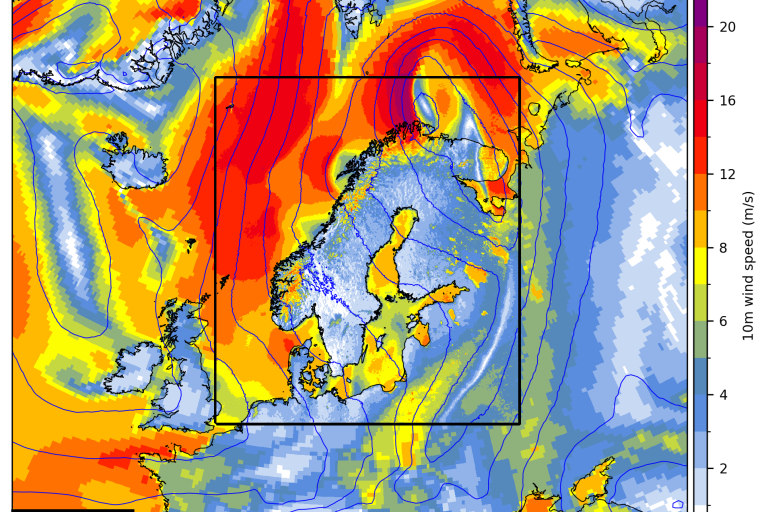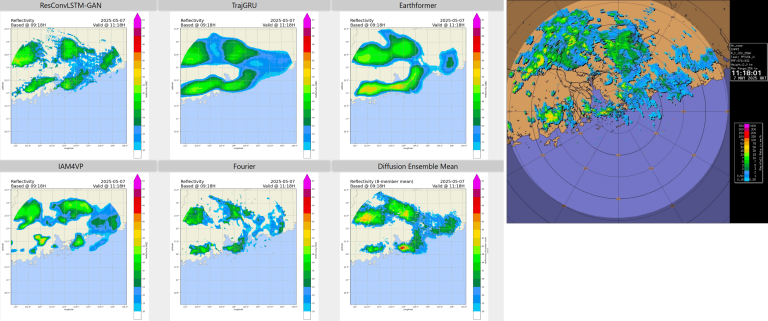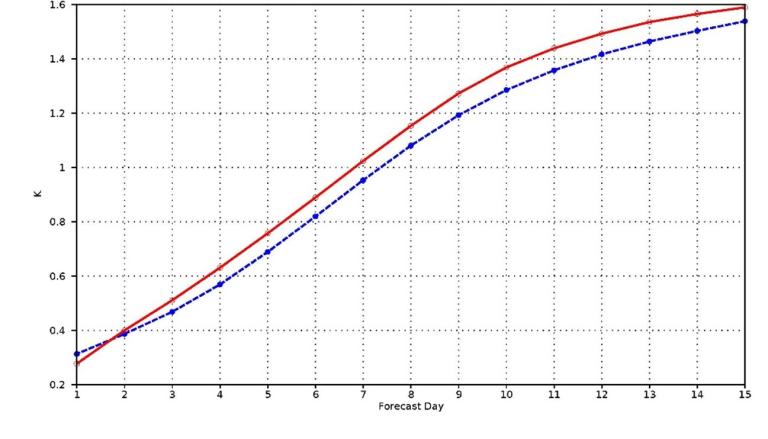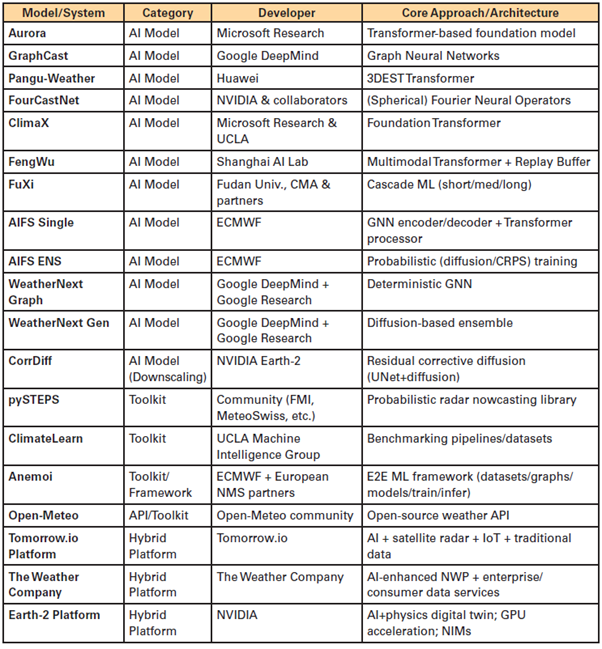Forecasting the Future: The Role of Artificial Intelligence in Transforming Weather Prediction and Policy
- Author(s):
- By Michel Jean, President of the WMO Commission for Observation, Infrastructure and Information Systems (INFCOM) and Emeritus Associate, Environment and Climate Change Canada, Florian Pappenberger, European Centre for Medium-Range Weather Forecasts (ECMWF), Pak Wai Chan, Vice President, INFCOM, and Hong Kong Observatory, Hong Kong, China, and Véronique Bouchet, Nir Stav and Yuki Honda of the WMO Secretariat

Can artificial intelligence (AI) predict tomorrow’s weather better than traditional models? As WMO celebrates its 75th anniversary, this question is no longer hypothetical. AI is already reshaping how the global weather enterprise observes, forecasts and responds to Earth system events – from nowcasting severe storms to anticipating seasonal climate shifts.
Possible evolution pathways of the new AI ecosystem were recently discussed with the private sector and the academia in a series of WMO events. A recurring theme, articulated clearly by all sectors, was that the integration of AI into operational workflows would require investment in people, principles and partnerships to ensure trust, transparency and equity. This feedback will support discussions at the Extraordinary Session of the World Meteorological Congress (Cg-Ext (2025)) and will spark dialogue that will shape a forecasting ecosystem that works for all.
This article explores the evolving role of AI across the weather-to-climate spectrum, highlighting operational pilots, policy frameworks and real world applications that are already actively shaping forecasting practice today. It draws on a spectrum of initiatives, from shared, standards-based tools to modular AI forecasting platforms, to show how open science and collaborative innovation can empower all WMO Members – whatever their capacity level – to leapfrog into the future of forecasting to meet context-specific priorities.
The structure of the article follows a practical narrative: first examining AI’s technical capabilities across timescales including verification, then addressing governance, equity and, finally, emphasizing the irreplaceable role of human expertise. Each section builds toward a central theme: that the future of forecasting is not just technological – it can be made ethical, inclusive and deeply human.
From nowcasting to long‑term projections and decision support

AI is rapidly reshaping weather and climate prediction across timescales, from nowcasting through to medium-range and subseasonal-to-seasonal (S2S) forecasting and up to multidecadal climate projections. Integrating recent technological advances, WMO has been progressing on AI from the coordination of research opportunities (WMO Task Team on Artificial Intelligence for Weather (TT-AI4Wx)) to demonstrating the use of AI for improving the quality and accessibility of products of the WMO Integrated Processing and Prediction System (WIPPS) through various pilot projects. These include:
- In the nowcasting window (first few hours), deep-learning methods can blend weather radar, satellite observations and local meteorological and hydrological records to improve the accuracy of various nowcasts such as precipitation, solar energy, river flow and the prediction of hazards such as hail, wind gusts and lightning. The AI for Nowcasting Pilot Project (AINPP), jointly coordinated by the Commission for Observation, Infrastructure and Information Systems (INFCOM) and the Research Board (RB), aims to assess the skills of AI-based nowcasting products through intercomparison, investigating their operational value, exploring real-time dissemination methods and identifying pathways for technology transfer to Members that are developing States or Territories.
- Data-Driven Weather Forecasting for All (DDWF4All) is designed to deliver high resolution weather information from data driven predictions from the global down to the local scale, which may lay the foundation for a universal early warning system. Bris, a global data-driven model system with enhanced resolution over selected focus areas, serves as the cornerstone for “Forecast-in-a-Box”, a demonstrator to show the applicability of AI techniques seamlessly across regions and to establish a common framework that supports WMO Members, particularly in vulnerable areas such as Least Developed Countries (LDCs) and Small Island Developing States (SIDSs).
- ECMWF AI Weather Quest seeks to advance the quality and trustworthiness of AI-based sub-seasonal to seasonal (S2S) forecasting by providing an open, standardized framework to evaluate key parameters from AI-based S2S models while also establishing a global community to exchange knowledge and best practices. The project will foster innovation and interaction among National Meteorological and Hydrological Services (NMHSs), AI researchers and private sector entities to improve the understanding of AI-based S2S forecasts and their potential use for operational purposes.
The real significance of these advances emerges in practice when AI‑enhanced forecasts feed early warning systems and intelligent decision support tools. A further leveraging of AI to integrate forecasting tools and products will provide more adaptive, context-aware decision support. A fast-evolving frontier in AI-driven meteorology is the development of "intelligent advisors", a decision support system that integrates multiple AI agents, such as a Vision Language Model (VLM) to interpret nowcasting outputs and observations (e.g. radar and satellite imagery), a fine-tuned Large Language Model (LLM) for drafting weather bulletins and a Retrieval-Augmented Generation (RAG) agents to incorporate protocols and historical context. Such intelligent advisors, when properly designed and thoroughly tested, will be effective at orchestrating end-to-end workflows from data analysis to actionable guidance while aligning with operational standards and user needs.
Following well-established best practices, forecast verification and model evaluation remain crucial steps for ensuring that AI-based prediction systems are trustworthy and ready for operational use. Unlike traditional physics-based numerical models, AI-based Earth System Prediction (AI-ESP) models rely on training data rather than physical equations, which introduces new challenges in evaluating their robustness, the feasibility to generalize or scale up, fairness across regions, and physical consistency with established dynamical principles.
Recognizing this, WMO expert bodies, such as the Working Group on Numerical Experimentation (WGNE), the Joint Working Group on Forecast Verification Research (JWGFVR), and the Standing Committee on WIPPS, are advancing verification metrics and frameworks for fair evaluation and comparison of AI-based and physics-based weather prediction and hybrid systems through the Weather Prediction Model Intercomparison Project (WP-MIP). These frameworks aim to benchmark model skill while taking full consideration of the behavioural characteristics of data-driven models. The establishment of such standards will be critical for comparing AI-based products with traditional methods, facilitating transparent intercomparison and building user confidence.
Through open collaboration, rigorous testing and adoption of agreed verification protocols, WIPPS pilot projects can serve as a proving ground for AI prediction systems. They also serve as a testing ground for various open questions that need to be explored. These include: What are minimal observational needs for AI-based high-resolution local prediction systems? What conditions need to be met to allow the transfer of a model trained to perform well in one region to another region? What kind of capacity building is needed to allow more countries to step into the new technology? The pilot projects also offer opportunities to demonstrate various ways to cooperate and partner with peers, between global, regional and national centres, and between private sector and public sector. Thus, the pilots ensure that future operational integration is both scientifically sound and practically relevant to the needs of WMO Members.
To summarize, the weather enterprise envisages that AI will deliver faster, finer‑resolution and user-tailored information across all timescales. The WIPPS pilot projects will aim to establish how these techniques can be operationalized within WMO infrastructures and standards. Continued open‑source development, rigorous verification and capacity building will ensure that WMO Members worldwide, from developed regions to LDCs and SIDSs, will be able to harness AI‑enhanced weather and climate services to protect lives, support livelihoods and meet the United Nations Sustainable Development Goals.

Policy and governance: Navigating the new landscape
The AI revolution in Meteorology didn’t appear out of the blue, it was enabled by a data ecosystem that was established by the meteorological community over decades. The World Weather Watch (WWW) is one of the most significant achievements of WMO and its partners, enabling global cooperation in monitoring and forecasting the evolution of the different component of the Earth’s system. This data ecosystem was initially an academia and government driven activity but gradually became a true partnership between public and private institutions across the value chain, in particular as it relates to observing and data exchange systems along with the high-performance computing environment supporting data assimilation and numerical weather prediction. Recently, the decades long public effort in establishing observing networks (near the surface, in the atmosphere and from space), the established standard data coding and exchange and associated data assimilation into prediction systems in World Meteorological Centres, with the added ingredient of the open data policy, provided the reanalysis datasets on which Machine Learning (ML) algorithms could be trained. Thus, the public effort provided the substrate on which the AI/ML efforts of all sectors, including the private companies, could thrive. As AI and data-driven methods accelerate, this longstanding public–private partnership is entering a new phase with the private sector in an increasingly visible role.
This spectacular (r)evolution has been possible because of the availability of cheaper storage and computing power AND the availability of data, thanks to the various incarnation of WMO’s free and open exchange of data. This (r)evolution requires changes in traditional paradigms in many directions, but this article will limit its analysis to three areas:
- Fostering Collaborative Action on AI among the public sector (NMHSs and WMO entities), private sector and academic sector: This collaboration should build on principles outlined in the Geneva Declaration – 2019 and the Code of Ethics between WMO and the Association of the HydroMeteorological and Environmental Industry (HMEI)
- Allowing Contributions by Non-Traditional Sources to WIPPS: Non-traditional sources (private and academic sector entities or non-partner international/intergovernmental organizations) are envisioned to contribute to WIPPS, especially through AI-based solutions, to support public weather, hydrological, and climate services. The “how” components are being explored and will continue to be explored over the coming months and years
- Leveraging Technological Innovation and Expertise: The private sector and academia have already played crucial roles in advancing AI/ML technologies for environmental services. They are expected to accelerate the uptake of technological innovations and to provide cutting edge research and technical depth.
Australia, Canada, the European Union and other legislative authorities have developed policies on the development and use of AI systems. There are three.
First, the principles of openness, transparency and traceability shall be foundational for the effective integration of AI-ESP systems, especially those originating from non-traditional sources, into WIPPS. This is needed to prevent misleading information, to enable the effective and trustworthy use of data, products and services, and to ensure, when feasible, explicable AI-ESP. In a sense, this supports and emulates the WMO Integrated Global Observing System (WIGOS) principle of "known quality" for observations and data.
The second consideration pertains to the willingness of the public and private sectors to engage in shared and open data and tooling, coordinated open benchmarks and human-centred service design. To achieve these, there is a need to commit to standards, to ensure the long-term sustainability of products and services while respecting the single authoritative voice of NMHSs and aligning with existing policies. The WMO Joint Advisory Group on AI will examine whether the existing framework for numerical weather prediction is sufficient to achieve this.
The third consideration is to sustain and accelerate the implementation of the WMO open data policy to ensure that AI-ESP systems are trained on open and high-quality data on a regular basis. The WMO Unified Policy for the International Exchange of Earth System Data (Resolution 1 (Cg-Ext (2021)) is the cornerstone of the WMO community’s approach. This policy aims to ensure data availability across all sectors. The successful implementation of Resolution 1 requires many critical success factors, including the WMO Information System (WIS) 2.0 to facilitate data exchange and metadata for data quality to ensure "known quality" of observations and supporting longterm intercomparability, which is vital for high-quality training data for AI-ESP systems. Properly crafted arrangements will be paramount when engaging with commercial data providers, an area that will grow over time.
The current revolution will contribute to the closing of existing gaps in early warning systems and will bring an exponential growth in the development of products and services for all. This will only happen if properly designed policies, standards and fit-for-purpose governance are put in place to maintain the success of the meteorological enterprise while allowing flexibility and agility. Therein lies the challenge for the global WMO community.
Disaster risk reduction, equity and capacity building
AI is increasingly central to disaster risk reduction and early warning systems, particularly in regions most vulnerable to climate change. By enhancing predictive capabilities and enabling faster decision-making, AI offers a leapfrogging opportunity for LDCs and SIDS, where traditional infrastructure may be limited.
Several recent initiatives demonstrate this potential. In East Africa, AI-enhanced rainfall forecasts are supporting anticipatory action, helping communities prepare for extreme weather events. In Kenya, mobile apps like MyAnga use satellite and meteorological data to guide pastoralists through drought conditions – saving time, protecting livestock and improving resilience. Globally, AI is being used to model displacement risks in climate hotspots such as Burundi and Chad, informing humanitarian planning and adaptation strategies.
AI-based forecasting systems are also being piloted through collaborative efforts between research institutions and operational centres. For example, the University of Oxford, World Food Programme, Intergovernmental Authority on Development (IGAD) Climate Prediction and Applications Centre (ICPAC), European Centre for Medium-Range Weather Forecasts (ECMWF) and Google have partnered with humanitarian agencies to deliver AI-driven rainfall forecasts tailored to local needs in East Africa. These models combine physics-informed approaches with ML and are designed to be open, reproducible and deployable without high-performance computing infrastructure.
Equity and capacity building are essential to ensure these benefits reach all communities. Open-source frameworks, cloud-based platforms and shared datasets reduce barriers to entry, allowing national meteorological services to adopt and adapt AI tools. Training programs are helping forecasters develop new competencies, including AI literacy, ethical oversight and the ability to interpret and communicate AI outputs effectively.
Citizen science and mobile-based data collection can enrich AI models by providing local context, improving relevance and trust. At the same time, collaboration across public, private and academic sectors is vital. While technology companies have contributed significantly to advancing AI-based forecasting, transparency and reproducibility must remain guiding principles – especially when integrating AI into operational systems.
As AI becomes more embedded in early warning systems, it must be supported by inclusive governance, interoperable standards and sustained investment in capacity building. Through collaborative efforts and open innovation, AI can enhance resilience and ensure that all communities, regardless of resources, benefit from timely, trusted and actionable forecasts.
The human element
At the heart of weather services are human needs – from farmers making planting decisions to emergency managers preparing for disasters. While AI provides powerful forecasting tools, human judgment will probably remain irreplaceable in interpreting forecasts for real-world contexts. The ability of language models to create reasonable human-like texts of forecasts, advisories and warnings will undoubtedly require that NMHSs adapt and consider where humans should stay in the loop. While some routine forecasts might, at some point, become fully automated, critical forecasts and warnings that significantly relate to safeguarding lives and property will probably remain under scrutiny of human experts.
Meteorologists are expected to serve as vital communicators, converting complex AI outputs into actionable guidance, validating AI results against physical plausibility while ensuring warnings account for vulnerabilities and social inequities. By ethically combining meteorological expertise with contextual judgment, they can transform technical outputs into lifesaving guidance. To maximize AI's benefits, forecasters will need to develop new competencies
- AI literacy: Understanding model strengths, limitations and biases
- AI collaboration: Effectively integrating AI tools into workflows
- Ethical oversight: Ensuring responsible AI use through transparency while prioritizing public safety and equitable access
An urgent revision of current education and training programs, along with recruiting practices, is highly relevant considering the usual timeline for curriculum changes. A fully enabled workforce would require technical skills in pre-developed AI model implementation and running as well as in the interpretation of AI/ML-based model outputs, value-add services and user requirements, etc.; experience in the collection of societal data that feeds AI/ML-based decision models; and an understanding of the legal and ethical aspects of AI (biases, quality, transparency, etc.).
Furthermore, for organizations who are developing fully “in-house” AI/ML models, there is an additional need for expertise in computer science, AI development, software architecture and development and for expertise in IT architecture and operations (High-Performance Computers (HPCs), Graphics Processing Unit (GPU) clusters, data storage and access maximizing data mobility, cloud computing). The skills listed above are in high demand in both the public and private sectors. Organizations striving for in-house development will be exposed to growing competition from big tech corporations adding further complexities to workforce retention.
Exciting developments and pilot projects within the WMO community that explore the application of AI-based services should be shared as widely and as quickly as possible, particularly regionally focused implementations, so that others can leverage these opportunities through first-hand knowledge transfer.
As the field evolves, nurturing these human skills will be as crucial as advancing the technology itself, ensuring meteorological services remain relevant and reliable for all who depend on them.
Conclusions
AI is redefining the boundaries of what is possible in weather and climate prediction. From nowcasting to seasonal forecasting, its ability to deliver faster, more accurate and more accessible insights is already reshaping operational practices. Yet, its transformative potential will only be fully realized through thoughtful integration, robust evaluation and inclusive governance.
WMO and its partners must lead by example – championing open-source models, transparent verification standards and equitable access to data and tools. Anemoi and the WIPPS pilot projects demonstrate how collaborative, reproducible approaches can empower all Members to benefit from AI-enhanced forecasting.
The WMO AI conference in September, hosted by United Arab Emirates (UAE) National Centre of Meteorology, confirmed that it is in the interest of WMO Members, academia and private sector to jointly developing common foundational principles for ethical progress and effective integration of AI in the weather enterprise field, grounded in openness, reproducibility, transparency, collaboration, sustainability, innovation and knowledge creation. The participants engaged to continue dialogue at multiple levels and to maintain higher-level strategic consultations to ensures the business model works for all as well as increases the representation of the private sector and academia in relevant WMO working structures.
Within this framework, human forecasters remain central. Their judgment, ethical oversight and communication skills are essential to translate AI outputs into actionable guidance. As the WMO community moves forward, investments in technology and people will be key to ensuring that meteorological services remain relevant, trusted and responsive to the needs of all communities.
Together, we can shape a future where AI strengthens – not replaces – the global forecasting ecosystem.



